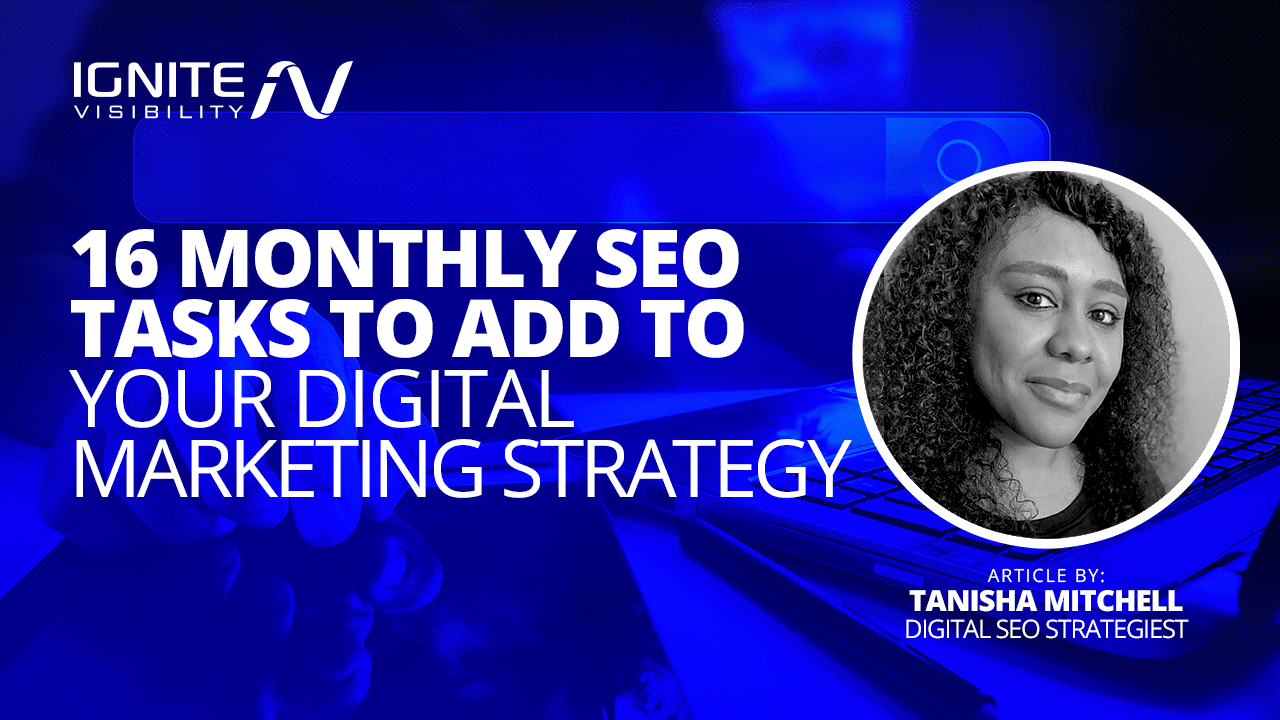
Include these 16 monthly SEO tasks in your digital marketing plan, and you’ll be much more likely to see your SEO strategy succeed.
What You’ll Learn:
- Optimize Existing Content
- Evaluate the Quality of Your Content
- Remove Low-Quality Content
- Keep Tabs on Your Rankings
- Analyze the Competition
- Stay Up to Date With the Industry News
- Check the Technical Aspects of SEO
- Make Important Link Updates
- Optimize for Voice Search
- Engage With Users
- Review Schema Opportunities
- Conduct New Keyword Research
- Analyze for Mobile Friendliness
- Review Featured Snippets
- Examine Entity Salience
- Optimize Landing Pages
Our Expert’s Insight on Monthly SEO Tasks
Tanisha Mitchell, our SEO Strategist says, “Embracing a monthly set of SEO tasks is more than just an addition to your routine—it’s a strategic move towards consistent visibility and connection with your target audience. Each task ensures your website remains optimized, relevant, and competitive. Remember, in the realm of SEO, it’s consistency and attention to detail that separate the leaders from the followers.”
Consider your website as a vehicle, and SEO as its maintenance schedule.
Just as your car’s maintenance checks and tune-ups improve its lifespan and performance, regular SEO health checks and optimization tasks for your website ensure it remains functional and visible. You’re essentially changing the “website oil” (updating content), rotating the “SEO tires” (refreshing keywords and meta tags), and checking the “digital breaks” (ensuring links are working and pages load quickly).
If you put off monthly SEO maintenance tasks, you risk losing your search engine ranking to competitors, damaging your site’s health, and diminishing the user experience, which could be significantly more challenging and costly to resolve down the line.
Integrating a routine set of monthly SEO tasks into your marketing strategy ensures you stay consistent, efficient, adaptable, and able to track your SEO performance effectively.
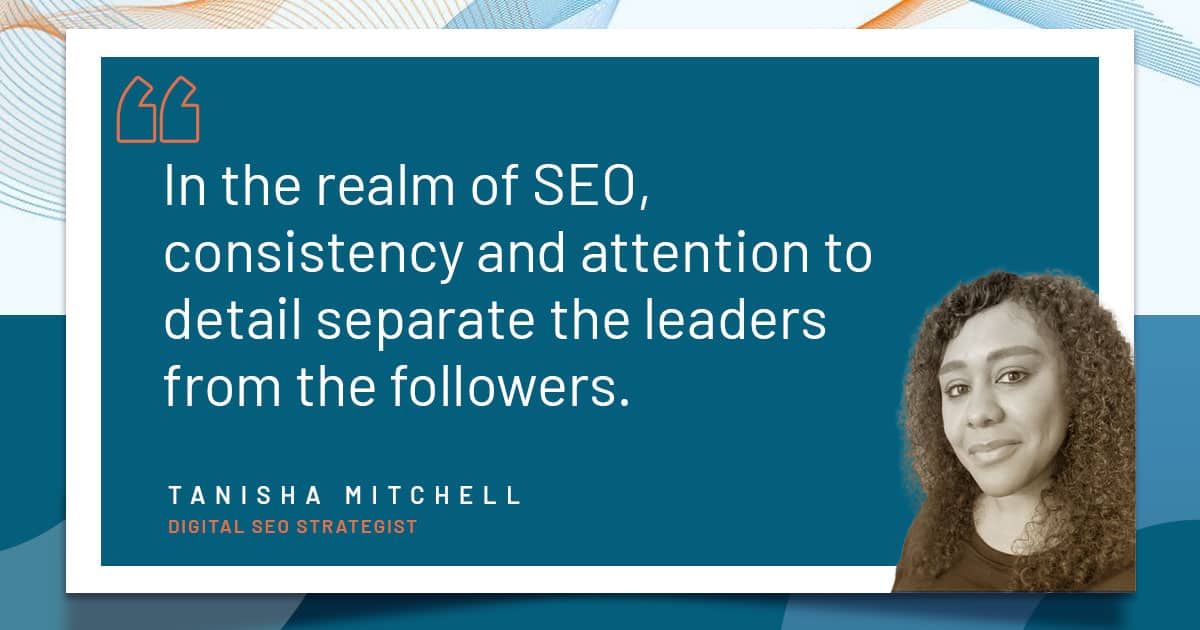
Consistency, Efficiency & Adaptability
Suppose you publish a page today. You check back in a couple of days and it’s ranking well in the SERPs. Fantastic! However, SEO is not a one-time activity, but rather a persistent process.
Your competitors aren’t stationary, and neither are the algorithms that decide your website’s rank. This is where having consistent, monthly SEO plans keeps your site proactive.
Besides consistency, efficiency will help you solidify your monthly SEO plans.
Random or ad hoc tasks often lead to ineffective attempts, low-impact results, or redundant efforts, burning both time and resources. With a well-defined task list, you can focus on high-impact items, such as optimizing meta descriptions or growing your backlink profile.
And like many things, change is the only constant in the SEO landscape. Search engines tweak their algorithms regularly to provide users with the most relevant search results.
Adaptability is the key to success here. Staying in the loop with frequent changes will help you adapt your monthly SEO tasks to evolve with industry standards.
Finally, having a monthly SEO task checklist will simplify tracking and reporting, helping you identify trends that are working and adjust what’s not quicker.
1. Optimize Existing Content
If you’ve been working in content marketing for a while, your library of content may not 100% meet your latest (or highest) standards. After all, both SEO and your marketing quality are evolving with time.
Action Item: Have content experts sift through old content and determine if it’s still suitable for publication, or if it could benefit from some tweaks.
Once you decide that you want to refresh a piece of content, take a look at things like:
- Titles
- Subheadings
- Meta descriptions
- Focus keywords
- Media (such as video, animations, or images)
- Facts and statistics
- The content itself
Your old content may have titles, subheadings, and meta descriptions that don’t align well with today’s SEO best practices. Here are some common examples:
- The media you embedded in the content could be outdated or no longer live
- Blogs could focus on a certain year that has since passed
- Links to external sources could have changed
2. Evaluate The Quality of Your Content
Who told you content quantity is top dog? It’s the quality of your content that reigns supreme.
Evaluating content quality is not as abstract as it sounds. What you’re looking for is rich content.
Rich content is robust. It contains multiple forms of media (e.g. text, video, and infographics). It provides tons of information that your audience can act on, much like service journalism but from a content marketing perspective.
Action Item: Get familiar with EEAT – Experience, Expertise, Authoritativeness, and Trustworthiness. Aiming to produce content that hits these four quality pillars will not only be beneficial to your reader but it is also a huge part of Google’s algorithm, as stated in its Quality Rater Guidelines.
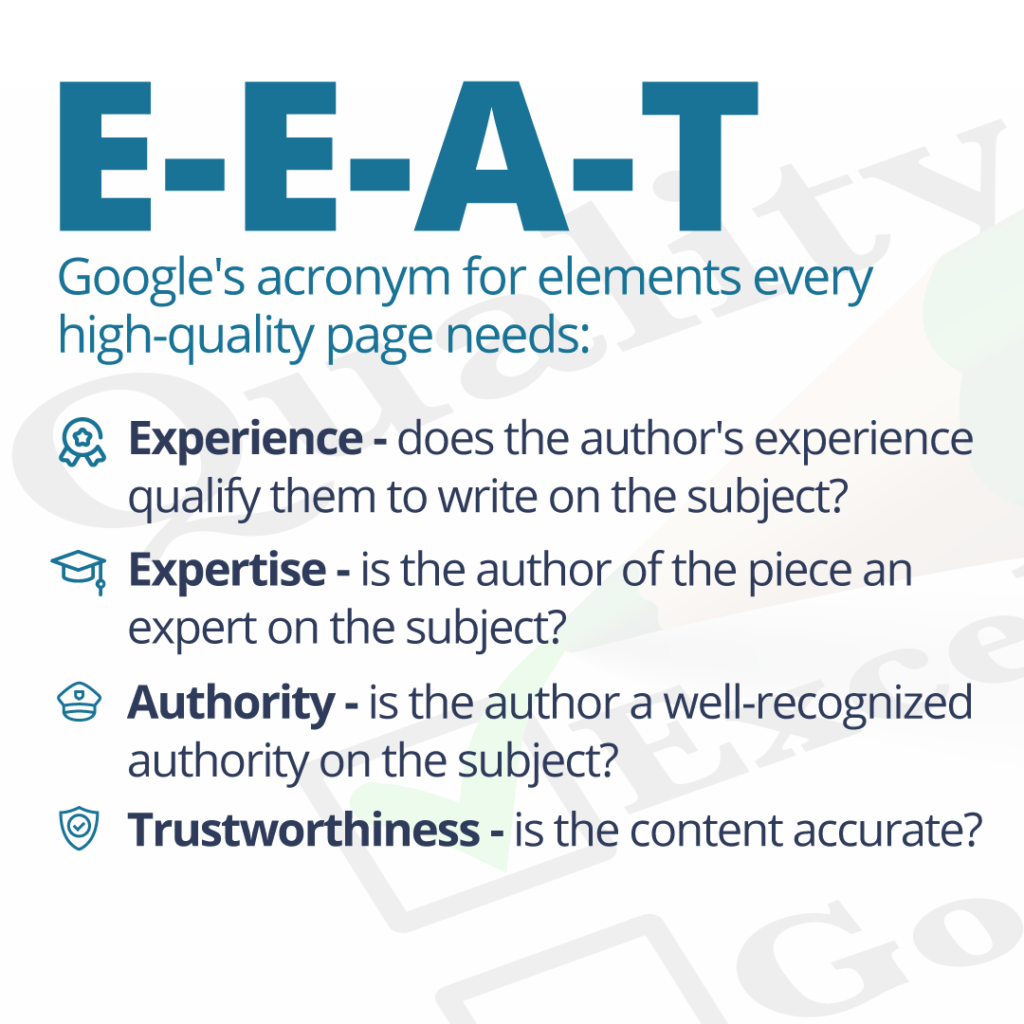
E-E-A-T
3. Remove Low-Quality Content
While optimizing old content should be part of your content plan, not all old content or pages are worth the time and effort it takes to refresh or optimize. You should have a system in place to determine which pages are so low quality that they should simply be removed from the archives altogether.
So how do you know which pages have a low enough quality that they should be removed? Focus on thin content. This just means it adds minimal value (if any) to the end-user. Much like you want to prioritize rich content, you want to eliminate thin content.
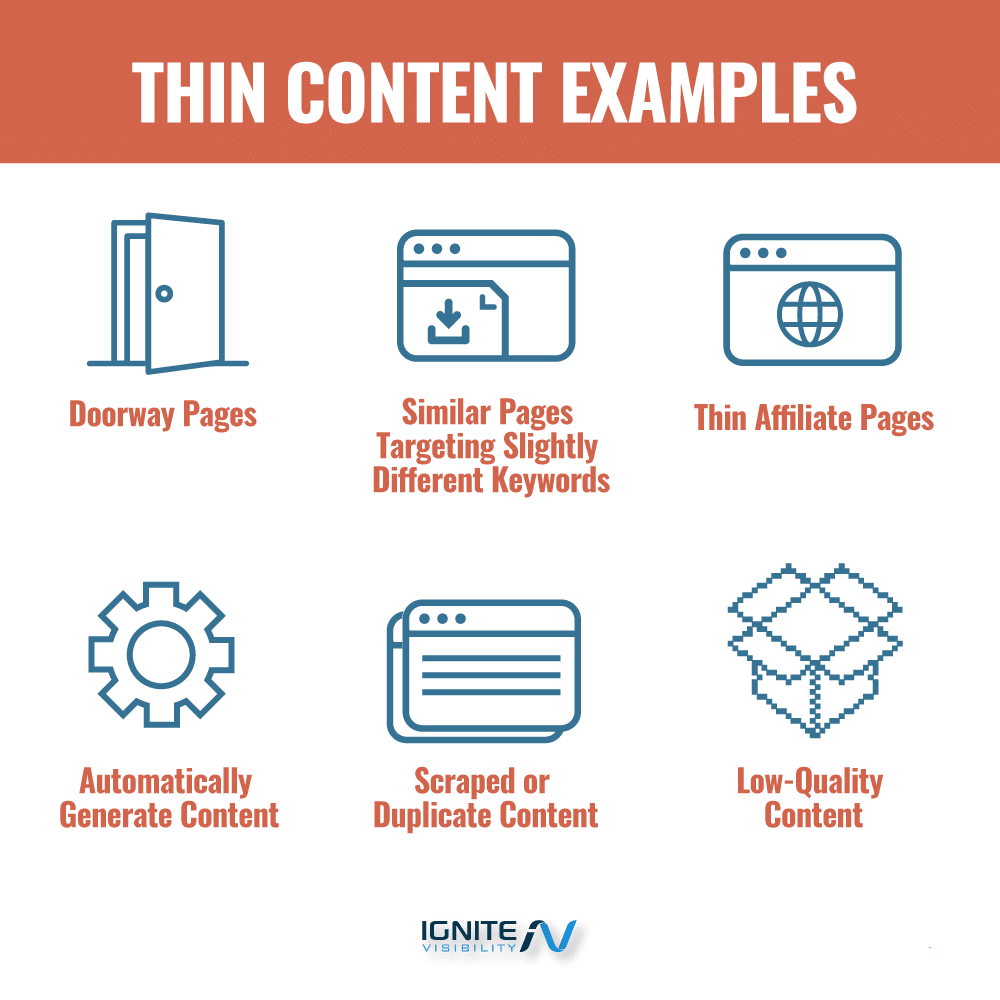
Examples of Thin Content
There are a couple of ways to remove pages without messing up your SEO:
- Do a 301 redirect from the page to another URL
- Add a noindex tag to the page
- Canonicalize the page to another URL
4. Keep Tabs on Your Rankings
Google SERPs can change in an instant. Unfortunately, new competition comes just as quickly. Because of this, add “check rankings” to your list of monthly SEO tasks. This will help keep your digital marketing plan dynamic so you can respond to the most recent needs.
To check your ranking for certain keywords, use tools like Google Search Console.
If you decide to use Google Search Console, head to “Performance” and scroll through the results to see which queries and keywords you show up for in search results.
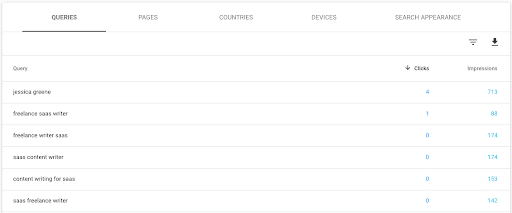
Example of Google Search Console
5. Competitor Analysis
Analyzing your competition gives you a starting point to practice benchmark marketing, where you will use your competition as a benchmark for your own unique SEO performance.
The most important part is to define 3–5 key performance indicators that you’ll determine results from. In the case of SEO tasks, you may want to include things like the number of keywords that a website is ranking for, how many number-one positions they have, and clicks.
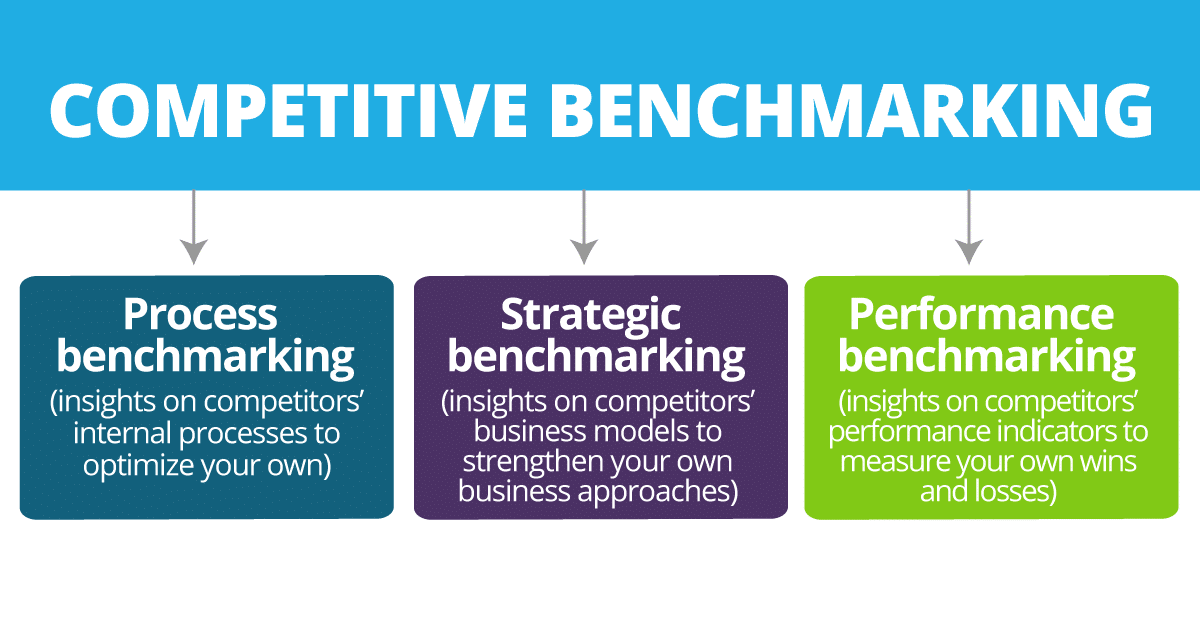
Subsectors of Competitive Benchmarking
Check out this video to learn how to use competitive analysis through benchmarking in your marketing plan:
6. Stay Up to Date With Industry News
The best way to know what is happening in the industry is to stay alert and make a conscious effort to consume the news.
The best way to do this is to find a voice of authority that you trust to deliver up-to-date and correct information.
Pay attention to digital marketing news and news within your specific industry. Stay up-to-date on noteworthy changes like Google algorithm updates and industry-specific regulations.
Big news most likely means it’s time for you to switch up your marketing plan or monthly SEO tasks.
7. Check on Technical SEO
Checking the technical aspects of SEO can be tedious, but adding it to your monthly SEO tasks actually makes the job way easier.
By breaking up the technical checks in your digital marketing plan with a monthly to-do method, you’ll be more thorough in your search. Plus, you’ll find technical issues sooner rather than finding them weeks after the issue took place.
When you’re performing these technical checks, watch things like:
- Crawl reports
- Errors
- Duplicate content
- First input delay (FID), largest contentful paint (LCP) and cumulative layout shift (CLS), aka Google Core Web Vitals
- Broken internal and external links
- URL structures
- HTTPS site protocol
- XML sitemap and robots.txt file optimization
- Accuracy of schema markup or structured data
You can use tools directly from Google to help you with the technicalities (e.g. Search Console, PageSpeed Insights, Analytics, and Mobile Friendly Testing Tool).
Third-party tools you may want to consider include Screaming Frog and SEMrush.
8. Make Important Link Updates
The use of high-quality links throughout your content has the potential to give you a serious SEO boost.
Keeping tabs on these links is an important part of your monthly SEO tasks. That’s because content creators (like you) change things up all the time. That can mean removing pages, changing URLs, or directing pages to other destinations. One thing you don’t want to do is send your readers to a broken, outdated link.
As you update your content, make sure that any linked material is relevant, current, and helpful to your reader.
9. Optimize for Voice Search
In today’s digital economy, users want shortcuts for finding the content they need. Voice search makes it easier and faster to ask a question and get an answer in seconds. Not surprisingly, 50% of the American population uses voice search daily and 71% of users prefer it to typing.

Projected Number of Voice Assistant Users
Optimize your content for voice searches by creating content that answers real user questions quickly and clearly.
To better understand what users want to do, conduct keyword research. This is especially important if local SEO is your priority. A lot of people will search for things near them and, if you’re a brick-and-mortar depending on walk-in traffic, you need to focus on voice search optimization tactics.
10. Engage with Users
Steps to hook local users. Be sure to claim your Google Business Profile and optimize your profile and reviews.

Google Business Profile
You can also look into paid options, such as Google Guaranteed, to see if it might be worth it to your business’s bottom line.
Another approach is staying active on your brand’s social media profiles. Whether you rely on the free opportunities these channels create or lean into the paid ads side, social media opens a lot of doors for brands.
The engagement you’ll get through social media gives you a chance to link to your content, get to know your audience and build a legit brand that reflects what they want to see.
11. Review Schema Opportunities
Another SEO tactic to try is optimizing your schema opportunities. Schema is essentially a roadmap to your website that you hand over to the search engines’ crawlers without making it obvious to your readers.
Schema, specifically Question & Answer Schema or FAQs, are incredibly helpful when it comes to crawlers determining what your site is about. If you take advantage of schema opportunities, you’re essentially helping the algorithm do its job. And if you can help influence it, why wouldn’t you?
12. Conduct New Keyword Research
What people are looking for is constantly changing and because of these trends, so are popular keywords.
While users consistently update their preferences and search queries, your competition is optimizing their content to outrank yours. This is why you might be number 1 on the SERP one day for a particular keyword but drop down to spot 3 or 4 a few days later.
To stay on top of this, make sure you refresh your keywords often. Don’t rely on popular keywords from a year ago. Conduct keyword research on a consistent basis so that you’ll always be able to have fresh and relevant content.
13. Analyze for Mobile Friendliness
People are accessing your site on their mobile devices and if your page isn’t ready for it, they’re going to click right off.
Not only does this affect your user experience, but it also affects Google’s crawlers’ experience. If the algorithm can tell that your site does not translate well to a mobile device, your ranking is going to take a totally avoidable hit.
When analyzing for mobile friendliness ask yourself the following questions:
- Is the layout okay?
- Does your message come across the same?
- Do the buttons work?

Mobile Usability
14. Review Featured Snippets
Google’s Featured Snippets are another place you can use to grab your audience’s attention.
The downside of Featured Snippets is that you can’t opt into them. Google chooses which site would make a good featured snippet.
The upside of this, though, is that you can get a little peek into what Google is looking for when looking at the Featured Snippets that come up for your preferred keywords. If your page wasn’t selected, look at the pages that were, take some notes on things they did, and then recreate it on your page, putting your spin on it.
15. Examine Entity Salience
Entity Salience is a move beyond traditional strategies that focus excessively on keywords. Instead, it encourages you to offer a thorough and contextually rich exploration of a topic. It’s an advanced approach that emphasizes understanding the relationship between different subjects or “entities” within your website’s content.
Google can now recognize entities and understand the links between them within a text. This marked evolution enables Google to better comprehend the purpose of the content, enhancing its ability to serve more accurate search results, like the example below.

Related Entities to SEO
16. Optimize Landing Pages
Every page on your website, especially landing pages, should have a clear goal that aligns with the user’s position in the buyer’s journey. Do they need information? Are they ready to purchase? Depending on the user’s stage, your landing page should educate, convert, sell, or entertain.
Remember, your page or post can’t cater to everyone. A targeted approach results in a more efficient and effective SEO strategy.
Want to Get More Out of Your SEO Strategy?
Whether you’re looking to boost your keyword rankings, increase your online visibility, or improve your site health, Ignite can help guide your SEO strategy.
Hundreds of businesses have used Ignite to increase their website’s rankings. Whether you’re a plumber, HVAC contractor, plastic surgeon’s office, or auto dealer, we’re here to support your business goals.
Ignite can help with:
- Keyword strategy, including identifying high-volume keywords with targeted search intent
- Creating high-quality optimized content with natural keyword instances written for humans by humans
- On-page SEO, including title tags, meta descriptions, headers, and mobile-optimized content
- Off-page SEO by way of backlinks, social media posts, brand mentions, and public business listings
- Technical SEO, including SEO-friendly website structure and improving loading times
- And so much more!
Ready to get started? Contact us today!


